Another round, another second half flame out by the Parramatta Eels.
When they found themselves behind against Manly in the second half, they doubled down on some incredibly poor discipline and let the game slip away from them. Unfortunately, the team hasn’t learned the first law of holes – when you’re in one, stop digging.
The depressing thing for Eels fans is that things hasn’t changed much from last season. This is from last year’s post on the site after Round 8:
“When they have the majority of possession, they make metres quite well through the middle of the field. But when they’re unable to maintain that strong possession percentage, teams can consistently find metres (especially up the middle of the field) and the Eels are often gassed early in games to a point where they can’t contain them.”
After eight rounds last season, it seemed pretty clear they weren’t the same team as the one that reached the 2022 grand final, and would need a significant change to be relevant. In the end, they weren’t.
And after eight rounds in 2024, it’s clear they’re not even the under achieving 2023 Eels, they’re much worse. Yet they’re still chasing a style of play that the rest of the league has left behind. For a club with so many inherent advantages over the rest of the competition off field, it’s becoming embarrassing how little they’re using them to help the on field product.
You can talk about how they’re missing Mitch Moses until you’re blue in the face, but just like South Sydney and Lachlan Ilias, a halfback isn’t the reason for a team having an appalling season defensively. Luckily they have the bye this week, but return to face Brisbane and Melbourne after that. The pain for Eels fans is likely to continue.
So what, if anything is different for Parramatta this season? You could say nothing, but that would be wrong.
All that has changed is that their pack has aged a year, and most of them are well into the twilight of their careers and aren’t keeping up with the pace of the NRL in 2024. Their starting forwards (excluding hooker), have been the fourth oldest in the NRL this season at an average age of 28.5, and would be even higher if Junior Paulo was not coming off the bench.
Agile middles with good lateral mobility are worth a premium, and the Eels don’t really have any of them. They have an excellent forward pack for the late 2010s, but an abysmal one for the mid 2020s.
This shouldn’t be a dissection of Brad Arthur’s coaching capability. He’s been at the helm of the club’s best seasons in decades, even if they weren’t able to finally break their premiership drought. And if he was to part ways with the club, it’s likely that whoever follows him won’t have the same level of experience (Trent Barrett) or have produced similar results (Justin Holbrook), taking over an aging playing list with limited upside. For now he’s still probably the best option.
I’m going to start the deep dive this week looking at their margin by minute chart, as it shows when the downfall is occurring.
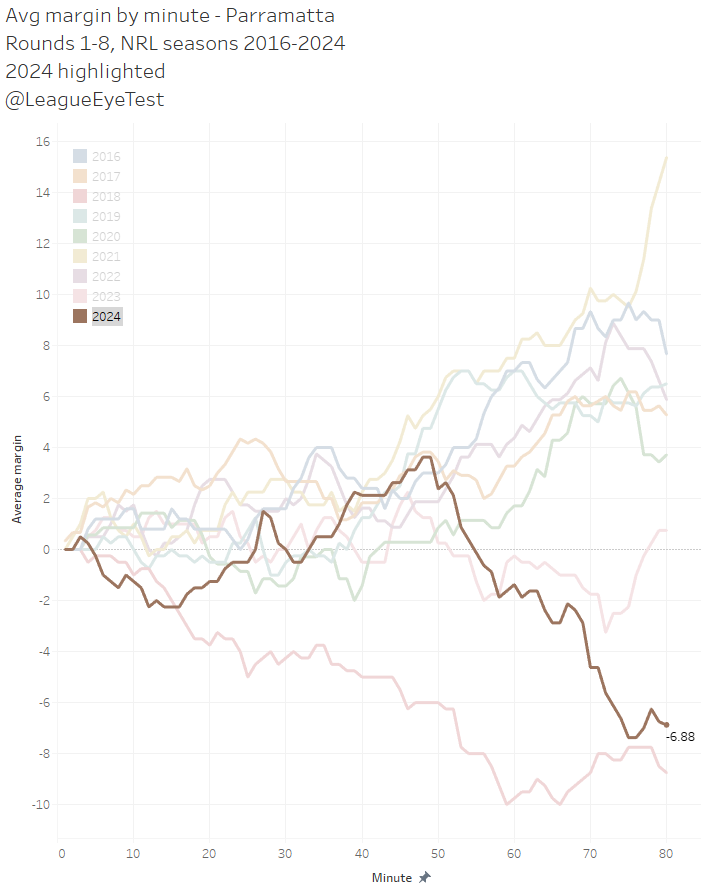
Their first halves have generally been pretty good this season, and their average margin after 40 minutes is +2.13 one of their best marks since 2016. And by the 48th minute it climbs to +3.63.
Then the clock strikes the 49th minute and the Eels turn into a pumpkin. From that moment on their margin drops rapidly and ends up 10.5 points lower by the end of the game, sitting at -6.88. That’s not far off the pink line you can see below it, which occurred during their disaster 2018 run that netted coach Brad Arthur a wooden spoon from a six win season.
When you look at some other metrics it’s easy to see why the decline is happening then. To set the scene, below is a chart of the rolling average of metres per run in an NRL game this season.
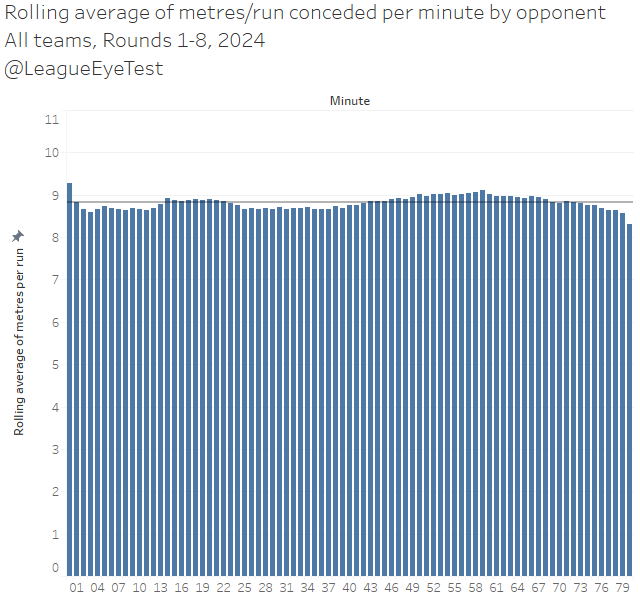
There’s very little difference across the course of a game in average metres per run. Generally, there are two small peaks, between 13-25 minutes as the first interchange of the half is made where metres per run increases, and again early in the second half where it rises above the league average. Towards the end of the game, it drops again as players tire and results are decided.
Now let’s check the same chart, with the same league average line, but for teams facing Parramatta.
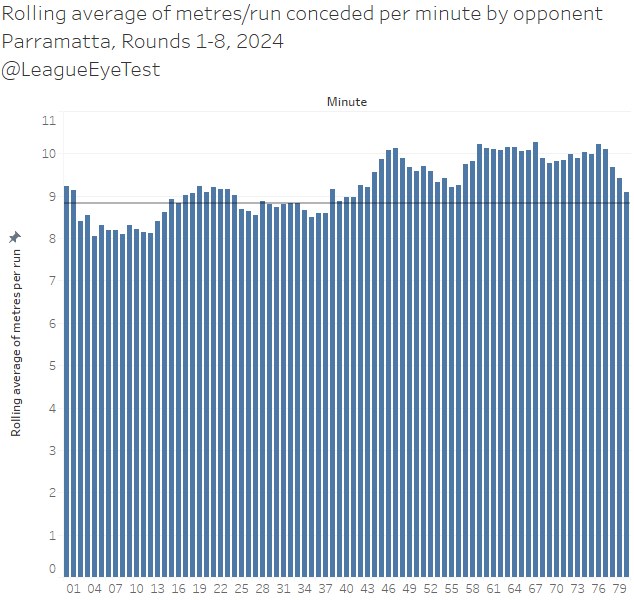
Yikes. The Eels concede more metres per run for the majority of game, including basically every minute of the second half, including a big spike around the 46th minute, which we saw before was just before their margin starts to tank. It appears for some reason, just after the second half commences the Eels just cannot compete anymore.
It might be fitness related, or mental lapses, or players simply getting older, but whatever the case the effort levels aren’t there for the whole 80 minutes and they’re giving up extra metres at a time when other teams aren’t.
Speaking of metres per run, keen readers of last week’s breakdown of the Bulldogs and Cowboys would have noted how poorly the Eels were faring running the ball and also containing their opponents yardage. Here’s an update of those charts from last week, starting with metres per run by team for 2024.

Dreadful stuff here, as the Eels are averaging just 8.07 metres per carry this season, dead last in the competition. That’s nearly 1 metre per run below the Broncos and Warriors.
One of the reasons this number is so bad is that the Eels do not have a regular forward whose metres/run average sits above the 63rd percentile. That’s Junior Paulo, and the next best is Joe Ofahengaue at the 50th percentile. Luca Moretti does rank in the 80th percentile but is playing less than 20 minutes a game and still has to improve other parts of his game.
There’s no damaging ball runner off the bench, there’s no strike back rower to eat up metres on an edge. Just a group of aging forwards who don’t generate the metres they used to.
Similarly, only a handful of Eels players are gaining more than their expected metres. Of regular players only Will Penisini and Bailey Simonsson run for more metres than an average player would in the same situation (field position and tackle number), and Moretti, Kelma Tuilagi and Blayze Talagi are the only others in the positives from a low sample size. Again, there’s no regular go forward from their starting pack.
And if you want an idea of how offloads are an irrelevant stat in a vacuum, the Eels lead the NRL in them with 102 this season, 15 more than second placed (the Roosters) and 20 more than third place (Wests Tigers). Second phase play is only useful when it generates more yardage, and Parramatta do it worse than anyone this season.
Flipping that last chart around, let’s now look at metres per carry conceded.

Another disaster for Parra here, allowing 8.98 metres per run, only in second place by 1 centimetre to St George Illawarra and only 2 centimetres ahead of South Sydney. You can point to Brisbane being not much better at allowing 8.82 metres per run, but they’ve proven over the last 18 months to have some excellent goal line defense which allows them to take more risks. Parramatta has no such luxury.
And when you combine this into net metres per run (gained minus conceded), it’s even more telling.

The blue and gold are allowing a cold as ice 0.909 metres per run more than they’re gaining this season, which is atrocious. With nearly an extra one metre per carry, that adds up to almost 5 extra metres per set allowed. Compounded over 35-40 opponent sets a game, these numbers add up. Additionally, that net metres per run number jumps up again to -1.1 net metres per run if you limit it to second halves only, again worst in the NRL.
It’s also the sixth worst team net metres per run mark in a decade after eight rounds, up there with the 2017 Knights and Titans, and the 2021 Bulldogs.

The teams above them finished last, last, 14th, 15th and last if you want an idea of how the Eels are traveling here.
If we breakdown metres per run allowed into pre and post contact metre components, you can see how much of this stems from a line speed issue.

The Eels allow the most pre contact metres per run at 6.33 per carry, ahead of even the dreadful Bunnies at 6.15, with Manly the only other team allowing more than six metres pre contact. Additionally, that 6.33 metres pre contact is the Eels worst since 2019. The Bulldogs performance here continues to stand out, as their forward pack has nowhere near the same level of names as the Eels, yet is consistently outperforming them defensively. It’s all attitude.
Parramatta are holding teams to just 2.62m per run for post contact metres, but keep in mind there’s fewer post contact metres to give up when you’re letting players like Jake Trbojevic amble through your defensive line untouched. You need to create contact to trigger post contact metres.
If it’s not becoming clear, the biggest issue is that the Eels are both old and slow. That’s not a knock on them, father time stops for no one. The strength still remains as players age, which is why they’re not suffering as much in post contact metres. But the speed and agility tend to drop off first. That’s what we’re seeing here with pre contact metres allowed.
What makes these numbers even more bizarre is that Parramatta should be benefiting from their opponents infringements. Below is the average total penalties (penalties and set restarts combined) awarded and conceded by team this season.

The Eels are receiving 9.3 total penalties per game, first in the NRL. They are conceding 8.0 which puts them mid pack, even after a dire second half penalty count against Manly on Friday evening, epitomised by Maika Sivo’s elbow that shut the window on any possible comeback.
With the running metrics we saw above, it’s almost unbelievable that the Eels season could be even worse if they weren’t on the positive side of penalty counts. For a breakdown of that total number the Eels are first in traditional penalties received and fourth in set restarts received.
This all gets compounded by the fact they don’t have much of the ball either in the second half. Only 13.0 complete sets in the second forty minutes , the lowest in the NRL, compared to 16.6 complete sets in the first half, sixth best in the competition.

Again, as we talked about last season, the Eels game plan is based around controlling possession and continual yardage gains, neither of which they’re doing in second halves this season. Losing Moses’ long kicking game probably doesn’t help in this regard, but there’s only so many bad field positions you can kick yourself out of.
Speaking of, looking at the Eels actual points scored and conceded over their expected point totals paints another grim picture.

The Eels are allowing 68.5% more points than an average team would given the same opponent field position and possession. Only Souths at 83% are worse than the Eels this season.
Part of this is that the Eels allow the second fewest expected points per game in the NRL at just 15.7 per game, only ahead of the Warriors (14.8). This means that Parramatta are mostly allowing teams to score tries from field position where tries aren’t usually scored.
If we look at their actual points scored compared with expected points yielded, we can see where they compare to the rest of the competition.

Parramatta sits very firmly in the ‘inefficient/unlucky’ quadrant, allowing just 15.7 expected points but giving up 26.5 points, the latter of which is the fifth worst mark in the competition. You don’t traditionally see teams that deep in the ‘inefficient/unlucky’ quadrant.
Teams that usually don’t give away field position usually tend more towards dominant as they will limit try scoring opportunities, and teams that give up a lot of points, usually give up field position as well.
It takes a special kind of bad defence to prevent opponents having good field position AND also give up a lot of points to them. If we look at the same chart by team and season, you can see where the Eels sit historically.

The only other teams that were this deep into the ‘inefficient/unlucky’ quadrant after eight rounds were the 2023 Wests Tigers and the 2022 Newcastle Knights. Not the most illustrious company.
This season, St George Illawarra has conceded 214 points from eight games, very similar to Parramatta’s 212 from the same number of matches. Yet if we compare the heat map of opponent play the balls for both sides, they’re quite different.
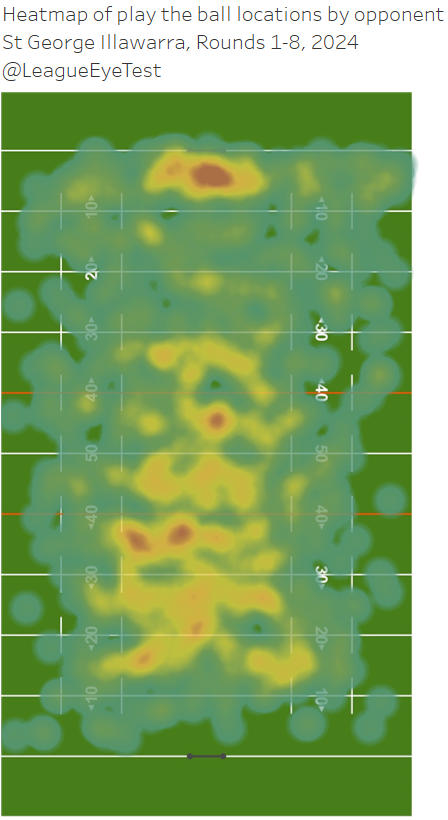
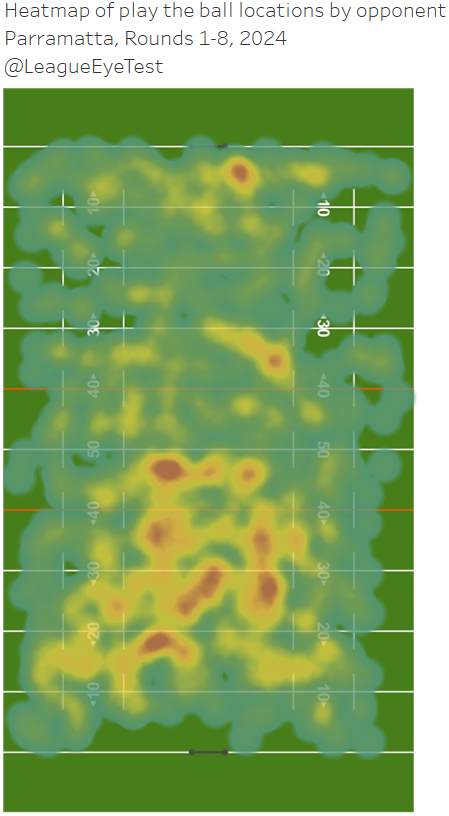
The Dragons chart looks like a team allowing a lot of easy points. A very high intensity spot (red) in the middle of their own goal line, along with other warmer spots in the 30-50 metre zone.
The highest intensity for the Eels opponent chart occurs in their own half, mostly between 20-40 metres out. There’s some smaller high intensity spots on the goal line and 35 metres out, but nothing like the Dragons heatmap.
In fact the Eels chart shares more similarities with Penrith’s (below) than the Dragons, despite the Panthers allowing 100 fewer points.
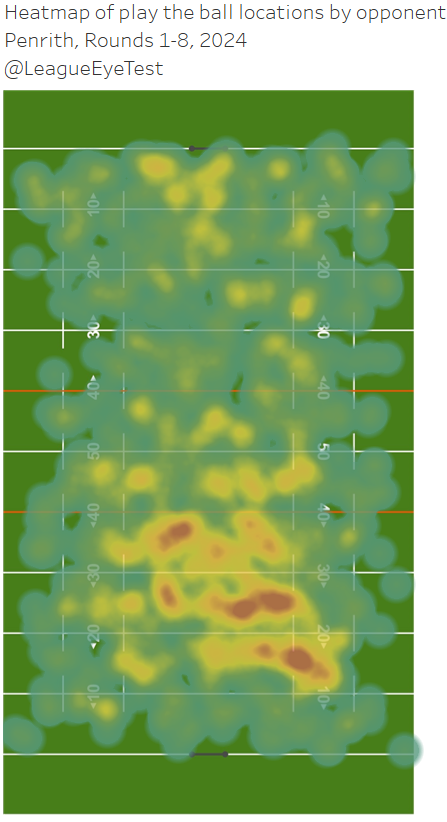
Even more astounding is that when taking out sets started inside 20 metres, the Eels have the best opponent starting position in the NRL at 26.8 metres, further emphasising how they are surrendering points from low expected value areas.
All of this raises one question to me – what is the exit strategy for this team? This is currently a team with no present and no future, only a past they’re desperately clinging to.
They’ve locked in the majority of their salary cap to a handful of players including multiple aging forwards on the wrong side of 30.
Reagan Campbell-Gillard will be 31 in July. Junior Paulo will be 31 in November. Joe Ofahengaue is 29 in September. Ryan Matterson will be 30 in October. Bryce Cartwright turns 30 in November. Shaun Lane turns 30 in November. Makahesi Makatoa already turned 31 in January. I’ve posted previously about when rugby league players hit their peak statistically, and every single one of these players is past that point.
This is a result of being all in on a current timeline and having zero options. Letting the likes of Stefano Utoikamanu, Oregon Kaufusi, Marata Niukore, Reed Mahoney and Isaiah Papali’i go within a short time frame without replacing them was always going to hurt the club’s depth. Other than lucking into J’maine Hopgood, they’ve mostly restocked the list with other teams cast offs and fringe first graders.
We’re now more than three seasons past Utoikamanu’s departure and two for the rest and the recruitment hasn’t replaced their absences or built for the current crop’s departure. If RCG and Paulo are only playing 47-55 minutes a match, what’s the plan for the other 30 minutes? Being so top heavy with salaries means depth is sacrificed. It means there’s no experienced backup for Mitch Moses, and no depth in the spine as a whole. Which again stems from paying too much for middles that are on the downside of their careers.
It’s not just an issue for the the forwards either, as Clint Gutherson will be 30 in November and Moses 30 in November. Time is about to expire on this list as a whole and there’s no off ramp visible.
Adding Zac Lomax next season is a step in the right direction, but he’ll already by 25 by the start of next season. Ethan Sanders could have been part of that but thanks to the amount of money tied up in the middle he was able to be picked up by Canberra. The glimpses of talent he showed against Manly were bittersweet.
Moretti showed some glimpses but has also had games where he’s dropped the ball on his first carry of the game. Wiremu Greig looked like he might be an option last season but has only appeared once in 2024 off the bench in the Eels capitulation to Canberra.
Matt Arthur certainly looks like he’ll be a quality first grade dummy half but by the time his body is ready for first grade, the current forward pack will be in their mid 30s. Who is there to bridge this gap? There’s no point having a gun dummy half if he has no one to provide service to.
It’s the same issue in the back row was well, where there’s been a significant lack of forward planning. The Eels still have three open places in their top 30, and by the time (or if) they are filled another season will be lost. Friend of the site Gol summed up their situation nicely in this week’s post game grades at The Cumberland Throw:
“…there are no young back rowers knocking the door down to push Shaun Lane (on that note, what happened to Toni Mataele?). With three empty roster spots this would be a simple fix if footballers grew on trees, but the Eels are perpetually active in a mid-season market that is as tight as the government purse-strings when somebody mentions Leichhardt Oval.
At some point, you have to recognise that this team, as it’s currently constructed, most likely hit their ceiling two seasons ago and even with a significant clean out it’s difficult to see where there will be any improvement in the short term.
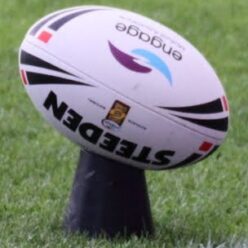

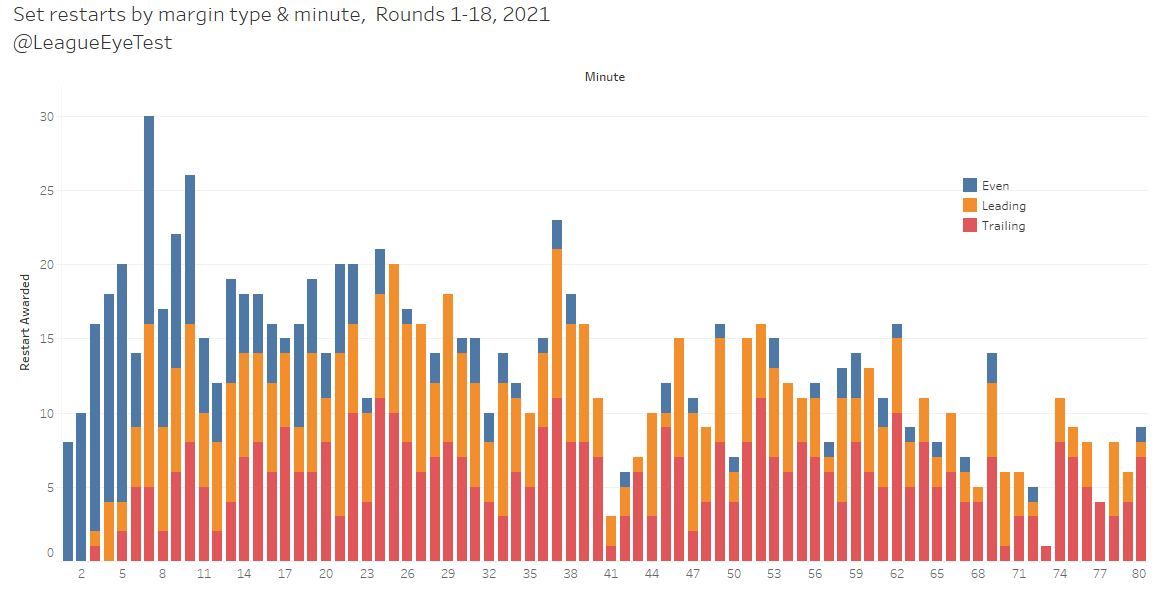
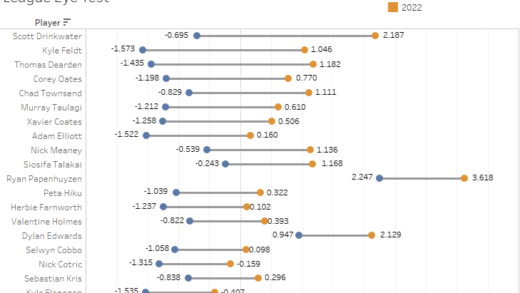
Excellent analysis, I think another thing to consider is the amount of work Eels forwards are expected to get through. I think it was last season, Eels back five had 2nd lowest share of team hit ups,
only more than Melbourne. So not only the forwards aging, they’re also expected to get through far more work than almost any other pack. Not surprised their metrics are this bad.
Is the minute by minute/play the ball location data publicly available by chance, or sourced yourself?
Very scientific analysis, if you are in to that kind of thing, but
I concede that the stats don’t lie. It all starts from the kick-off,
with the hapless player presented with the Football to take it up hit with the inevitable gang tackle, from there it is the forwards doing all heavy work particularly in the first 15 minutes with gang tackle after gang tackle. Certainly takes its toll when you throw in age, body wear and tear, injuries, the incessant pace of the game, and the 10 metre rule, about the
50 minute mark the Parramatta Forwards seem to go into oxygen debt and lactic acid build-up. Forget about Mitchell
Moses, he was only a shadow of his usual self before the
foot injury, was having dreadful problems allegedly with his groin, was it some sort of hernia, I ask ? But still a long way to go in the competition and I do not believe that the teams will be able to keep up this suicidal pace in the game. Blame the
10 metre rule for it all and the fanciful expectations of the electronic media. And notice how flat most teams are the week
after they play The Parramatta Eels. Parramatta were much improved against Manly and they get the Bye this week. Thought
Ethan Sanders went well against Manly and keep an eye on Ethan from now on. Personally I would like to see him at
Half-Back as I believe he has got a good kicking game. But all
you can do is front up with what you have got, Parramatta will do this, been doing it for 77 years since 1947, many a time when The Wooden Spoon was there only trophy.
This analysis is both fascinating and depressing for Eels fans. The question I have is, on whose watch has this been allowed to happen? Is this a failure of the Head of Football, the Coaching Staff, or the Recruitment and Retention team? Probably a bit of each I suspect, but it is an appalling lack of vision, strategy and leadship at what should be an absolute RL powerhouse. I’ve followed them since 1976 and always will, but gee, I’d love to steal the leadership from Penrith or the Storm……